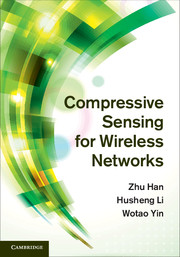9 - Multiple access
from Part II - CS-Based Wireless Communication
Published online by Cambridge University Press: 05 June 2013
Summary
Introduction
In this chapter, we discuss multiple access using CS in the context of wireless communications. Essentially, multiple access means that multiple users send their data to a single receiver that needs to distinguish and reconstruct the data from these users, as illustrated in Figure 9.1. It exists in many wireless communication systems, such as
Cellular systems: In cellular systems, the mobile users within a cell are served by a base station. The users may need to transmit their data during the same time period; e.g., multiple cellular phone users make phone calls simultaneously.
Ad hoc networks: In such systems, there is no centralized base station. However, one node may need to receive data from multiple neighbors simultaneously; e.g., a relay node in a sensor network receives the reports from multiple sensors and forwards them to a data sink.
The key challenge of multiple access is how to distinguish the information from different transmitters. Hence, there are basically two types of multiple-access schemes:
• Orthogonal multiple access: This type of multiple access includes time division multiple access (TDMA), orthogonal frequency division multiple access (OFDMA) and carrier sense multiple access (CSMA). In TDMA, each transmitter is assigned a timeslot and it can only transmit over the assigned time-slot. Hence, the signals from different transmitters are distinguished in the time. OFDMA has a similar scheme to TDMA. The only difference is that OFDMA allocates different frequency channels to different transmitters and thus separates the transmitters in the frequency domain.
- Type
- Chapter
- Information
- Compressive Sensing for Wireless Networks , pp. 214 - 231Publisher: Cambridge University PressPrint publication year: 2013



